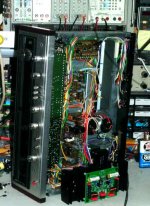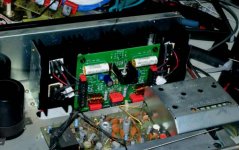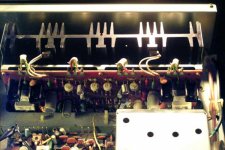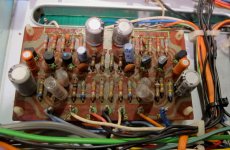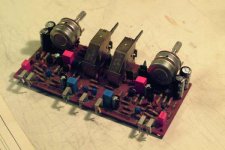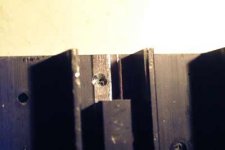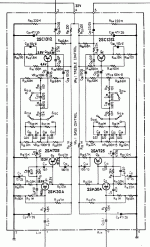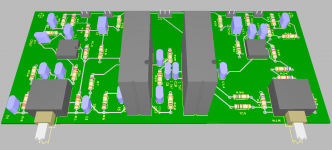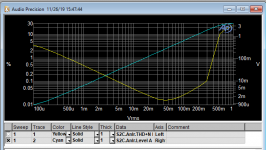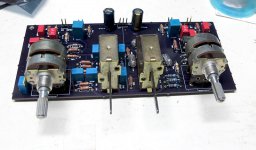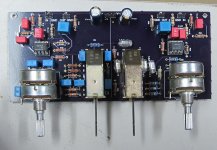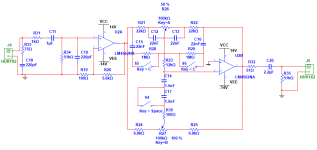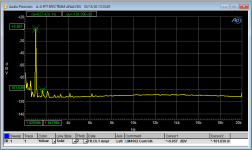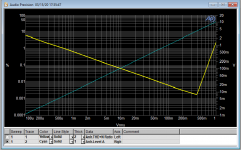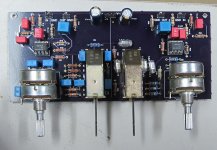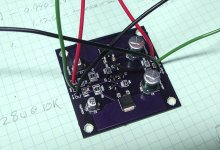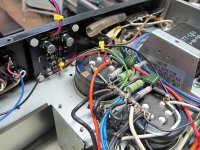The first "stereo" I purchased (as opposed to "built" or "received as a hand-me-down") was this Pioneer SX-838 -- I bought it used at Harvey Electronics on 45th Street and lugged it back to the apartment in Brooklyn Heights -- circa 1976. Still has one of the nicest FM receivers I own -- but the protection circuitry went wonky and the device would blow output devices all the time. If you can't find one of these receivers in the junk yard you can buy one on the Bay for about $30.
Turns out that the printed circuit boards I had burned for the LM4702 fit almost perfectly onto the heatsink for the Pioneer SX-838. I had to put the HS on the mill and grind down one of the fins a bit so that the spacers would fit:
Here's the original output board and its location:
The LM4702 Board mounted on HS:
Turns out that the printed circuit boards I had burned for the LM4702 fit almost perfectly onto the heatsink for the Pioneer SX-838. I had to put the HS on the mill and grind down one of the fins a bit so that the spacers would fit:
An externally hosted image should be here but it was not working when we last tested it.
Here's the original output board and its location:
An externally hosted image should be here but it was not working when we last tested it.
The LM4702 Board mounted on HS:
An externally hosted image should be here but it was not working when we last tested it.
Nest we have to tackle this -- and it is going to be a challenge to access the PCB w/o taking the whole thing apart:
An externally hosted image should be here but it was not working when we last tested it.
Changed out the coupling caps to WIMAs and BC Components, replaced old electrolytics with new Panasonics, increased the local filtering from 47u to 470u.
Even with the tone controls in the THD% is now down around 0.01%
Even with the tone controls in the THD% is now down around 0.01%
An externally hosted image should be here but it was not working when we last tested it.
I just noticed this project. I love it when old stuff becomes new! That looks like more fun that I would know what to do with!
Have fun. 😀
Have fun. 😀
One of the issues which all these devices had is that all the connections are wire-wrapped. These included the ground returns. Well, I brought all the ground connections to a central locus near the filter caps.
The volume pot had to go. No amount of DeOxit would cause it to remain clean through the sweep.
The amplifier electrolytics were 8,000 uF -- these were replaced by 39mF Panasonics which I had on hand. They are only slightly larger than the 1970's vintage filter caps.
One thing leads to another -- I have replaced all the electrolytics on the power supply board after noticing a low level buzzing - the power supply diodes went as well. It is much, much quieter now.
I must say that it sounds much, much better than the original. It is a receiver, after all, and the only function missing is the "Loudness" control (which was killed when the volume pot had to be replaced.)
The volume pot had to go. No amount of DeOxit would cause it to remain clean through the sweep.
The amplifier electrolytics were 8,000 uF -- these were replaced by 39mF Panasonics which I had on hand. They are only slightly larger than the 1970's vintage filter caps.
One thing leads to another -- I have replaced all the electrolytics on the power supply board after noticing a low level buzzing - the power supply diodes went as well. It is much, much quieter now.
I must say that it sounds much, much better than the original. It is a receiver, after all, and the only function missing is the "Loudness" control (which was killed when the volume pot had to be replaced.)
The pictures which were hosted on my website are no longer available via DIYAUDIO so I have replaced. I am having a new tone control board made which will fit onto the existing board -- and use one of Jan's "Silent Switcher" +/- 15V supplies. This will allow much greater headroom than the stock preamplifier board:
Attachments
Finally acquired another SX-838. In the interim, Tone board runs out of steam, even with the full +32V on the power rail.
New boards out for production, can use a high quality IC like LM4562N. They should fit "exactly".
New boards out for production, can use a high quality IC like LM4562N. They should fit "exactly".
Attachments
Finally got my boards burned:
Attachments
Last edited:
Are you sure about R19 and R20 values? 35 dB of gain seems just a tad high for a preamp on +/-14 V, just saying. It would clip around 150 mV input... with the tone controls in neutral.
What kind of pot value did you end up using?
You are well aware that the LM4562 has 1.6 pA/√(Hz) of current noise density?
Assuming that the desired gain was in fact closer to 16 dB, I would have advised to operate the tone control at line level, ahead of the volume pot... it's not the last word in low noise and would in all likelihood still dominate the gain stage.
What kind of pot value did you end up using?
You are well aware that the LM4562 has 1.6 pA/√(Hz) of current noise density?
Assuming that the desired gain was in fact closer to 16 dB, I would have advised to operate the tone control at line level, ahead of the volume pot... it's not the last word in low noise and would in all likelihood still dominate the gain stage.
Are you sure about R19 and R20 values? 35 dB of gain seems just a tad high for a preamp on +/-14 V, just saying. It would clip around 150 mV input... with the tone controls in neutral.
It comes in right at 35dB and clips at ~175mV
The SX-838 is a nominal 50W receiver, with the LM4702 driver chip set for 20dB gain on the final stage, I can probably drop the gain of the preamplifier.
Tone controls etc. aren't for the purists, but this should alleviate one of the big issues I saw with the receiver.
35 dB + 20 dB = 55 dB is waaay hot. A 50 wpc amp needs maybe 42 dB, and that's if you need to accommodate a phono stage with room to spare. (With high-level sources, issues with volume pot balance are not an uncommon sight as those often barely end up at 9 o'clock.) Try R19 = 470R.
Estimated basic noise floor comes out to about 130 µV like that (good), though worst-case with a 100k pot (at -6 dB) could be approaching 900 µV. Normal volume setting ranges (up to -30 dB) shouldn't be exceeding 250 µV, however. Noise at about -30 dB up would be better with an opamp sporting less current noise in the gain stage (including NE5532 and NJM2068, dropping worst-case noise by up to 6 dB with only a moderate penalty at minimum volume due to your 1k series resistor).
Estimated basic noise floor comes out to about 130 µV like that (good), though worst-case with a 100k pot (at -6 dB) could be approaching 900 µV. Normal volume setting ranges (up to -30 dB) shouldn't be exceeding 250 µV, however. Noise at about -30 dB up would be better with an opamp sporting less current noise in the gain stage (including NE5532 and NJM2068, dropping worst-case noise by up to 6 dB with only a moderate penalty at minimum volume due to your 1k series resistor).
Some results -- not surprising -- dialed back the gain to 20dB. Using one of Jan's "Silent Switchers" to power but this is a bit impractical within the carcase of the Pioneer SX-838 as it draws 200mA at a minimum.
Attachments
Last edited:
Still has one of the nicest FM receivers I own --
We had one too. That thing would really pull in stations. I used to stay up late with my headphones on, just listening to the radio.
but the protection circuitry went wonky and the device would blow output devices all the time.
Can't you bypass the relay?
If you can't find one of these receivers in the junk yard you can buy one on the Bay for about $30.
I've never seen one for $30.😱
jeff
The post you were quoting was from 2008. Prices probably haven't been like that in a decade now.I've never seen one for $30.😱
The curve looks really weird beyond 400 mV. (It should be near-vertical.) Is this just an artifact or could this be because you seem to have no local bypass caps for the opamps? 😱Some results -- not surprising -- dialed back the gain to 20dB. Using one of Jan's "Silent Switchers" to power but this is a bit impractical within the carcase of the Pioneer SX-838 as it draws 200mA at a minimum.
Also, I think noise floor may be dominated by the analyzer, seeing that it comes out to 4.5 µV (old circuit) / 6.5 µV (new circuit). That's all input-referred, right?
I think you could supply a circuit like this with the +32 V provided by the Pioneer, but it would definitely have to be modified for single-supply operation first, with caps in the feedback loop's ground leg and an R/RC divider for Vref.
The curve looks really weird beyond 400 mV. (It should be near-vertical.) Is this just an artifact or could this be because you seem to have no local bypass caps for the opamps? 😱
Weirdness owing to speeding through the analysis -- only 10 samples.
The post you were quoting was from 2008. Prices probably haven't been like that in a decade now.
Yeah I didn't even notice.😱 Ten years ago I paid $60 for an SX-636.
jeff
Yeah I didn't even notice.😱 Ten years ago I paid $60 for an SX-636.
jeff
I think I paid less than $100 for my second SX-838.
I can recall dragging the first (purchased from Harvey Electronics on West 45th St.) to our apartment in Brooklyn via the subways. The AM receiver section was (is) phenomenal and in the evening I could pull in stations from the midwest to our tiny apartment.
I also have a Yamaha from the era -- just replaced the relay in that one. Another very fine product! Unlike the Pioneer, I haven't used the Yamaha for LD listening.
Last edited:
Rebuilt the preamplifier section. I had intended to use one of Jan's "Silent Switchers" but was at an impasse in regarding pulling 5 - 10V off the original power supply. I decided to build a MOSFET cap multiplier in SMT and run it off the power rails.
The next magic act has to be replacement of the volume controls. Looks like a rotary encoder and Maxim or TI digital pots.
The next magic act has to be replacement of the volume controls. Looks like a rotary encoder and Maxim or TI digital pots.
Attachments
- Home
- Amplifiers
- Chip Amps
- LM4702 meets the Pioneer SX-838
